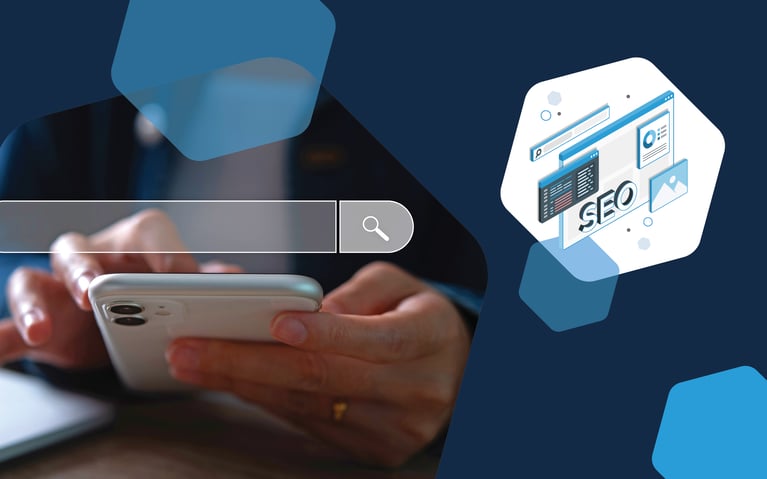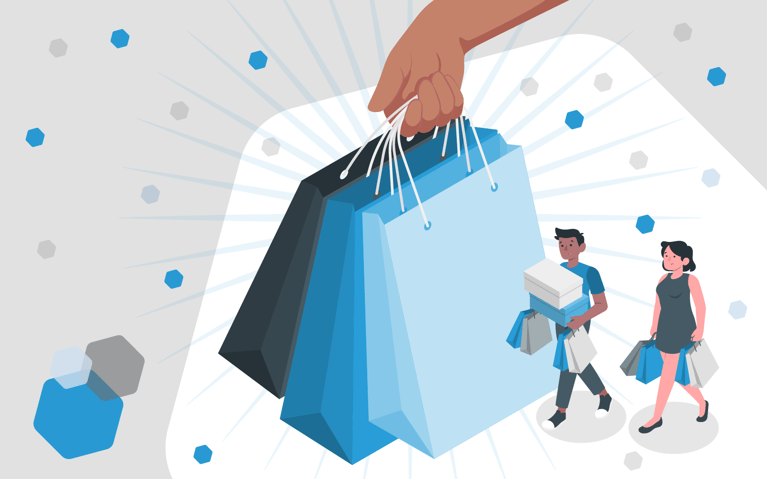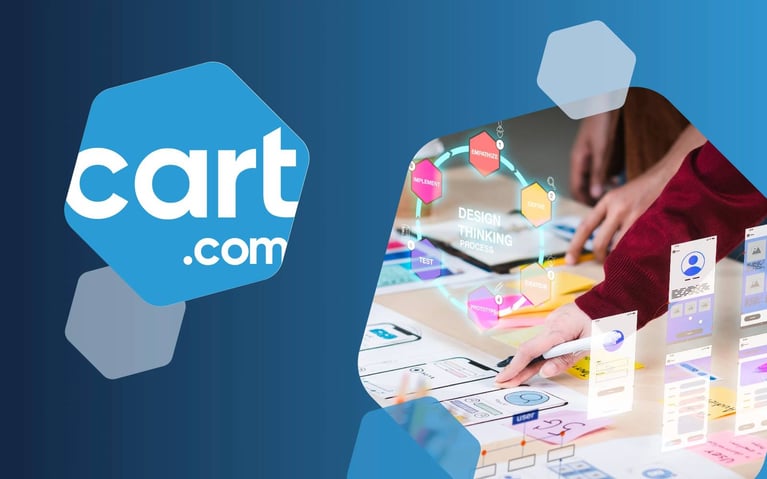If you're trying to grow your business, you may already know that inbound marketing can help. If you've tried cold-calling and similar outbound strategies, then try inbound marketing. This method finds people who are already interested in your products or services even if they're unaware of your business — yet. This saves you from having to constantly generate interest in the people you approach.
Though it may seem expansive, when you know what inbound marketing is and how to use it, it can be a very effective strategy to improve your customer acquisition.
The four stages of ecommerce inbound marketing
Ecommerce inbound marketing improves your process of funneling in potential customers who may not be aware of your business. Your goals and strategies are different at each stage of this process.
1. Attract potential customers
You can picture this as the top of a funnel. Here, you extend your reach as widely as possible to catch the interest of anyone who needs your products. As a result, you'll be using a variety of channels in this stage, including:
- Social media marketing
- Search engine optimization (SEO)
- Influencer marketing
To improve your ability to attract potential customers via these channels, it's best to determine your target market — the groups of people who would most likely use your products. Then, you can narrow down the areas where these people spend the most time online, directing your marketing efforts to these places.
The better you can identify people who would want to buy your products, the more people you can guide to the next stage.
2. Convert them into leads
A lead is interested in your business or products but may not be ready to make a purchase. As a result, you'll need to nurture them so that your business stays at the front of their minds until they're ready to commit.
The first step to nurturing them is getting their contact information so you can stay in touch. A common way to do this is with a lead magnet, which is a piece of free downloadable content like a report or ebook that you give in exchange for their email address. To make your magnet most effective, it should give them valuable, relevant, actionable insight. This way, they feel as if it's worth signing up for your email list.
Once you have a contact list to nurture, you can strengthen their connection with your brand by sending them emails with information that helps them solve a problem or teaches them more about your field. The more emails they read, the more you can get them invested in their problem and your solution to it.
3. Close the sale
In this phase, the potential customer has done their research and is ready to make a purchasing decision. A free trial or discount can encourage people at this stage to become customers, increasing your conversion rate. It's also good to leave them with a call to action (CTA), as sometimes leads are ready to act if you give them direction.
Once you get them to your ecommerce website, it's important to minimize friction in the purchasing process. Customers are fickle, and any barrier can cause them to abandon the sale before paying. You should focus on empowering customers to browse in the most convenient way for them (i.e. desktop or mobile). Plus, make it easy for them to check out in only a few clicks.
4. Delight with continued engagement
This is a stage people often forget. After someone makes a purchase, providing an additional service can encourage them to become a repeat customer or subscriber. As you gain more loyal customers, you'll need to funnel fewer new people into your inbound marketing funnel.
This loyal customer base is more likely to help grow your business with word-of-mouth marketing. They're also likely to engage in behaviors that help you improve your business, such as responding to surveys.
Customers' experiences going through the previous stages heavily influence whether you can bring them to this stage. However, make them feel more valued post-purchase. This includes improving your reverse logistics for returns or refunds and sending customers offers specifically relevant to them.
Why apply inbound marketing to your current marketing efforts?
Inbound marketing focuses on creating useful content to build meaningful relationships with current and potential customers. This approach helps you in many ways:
- Generates quality leads. The main goal of inbound marketing for ecommerce is to generate higher-quality leads by helping you find the people who need your product the most. As you learn to address their needs better, you'll improve the quality of your leads, raising the chance that they'll make a purchase.
- Raises brand visibility. Good inbound marketing content can make even a small brand with a minimal budget discoverable online, as long as it helps people solve a problem or satisfy a need/want. As people research ways to solve this problem, they can find your helpful content while learning about your brand.
- Access to data. Because you generally have more control over inbound marketing channels, you have more tools to collect data and run analyses. This means past campaigns' results can help you improve upcoming campaigns.
- Appeals to a digital audience. Since your ecommerce store is online, it makes the most sense to target your marketing efforts at people on the internet. After all, it's much easier to link someone to a landing page than to tell them a URL to type in.
- Gives your audience value. People often ignore ads that don't offer them any value. If you give them free content that's relevant and useful, they're more likely to visit the page you want them to as a way to pay you back. This also builds brand loyalty as they find more of your content valuable.
- Raises credibility. Inbound marketing shows customers that your business is keeping up with evolving trends in your industry to stay ahead of the game. This gives them more confidence in your brand.
- It's cost-effective. Because you can focus your efforts more specifically on reaching segments of your target audience, you get more ROI from inbound marketing than outbound tactics like cold-calling. It also helps you focus on people that are looking for something you sell, so you don't waste resources on making people feel they need your products.
- Sustainability. While physical content like billboards or posters runs for a period of time, digital content is available forever. Someone could find your brand through a video you posted five years ago, for instance. As a result, any content you post can always bring in new customers, making inbound marketing more sustainable in the long run.
- Focuses on the customer. Inbound marketing starts by identifying the customer's needs, rather than the business's. This empowers you to respond to their needs better, improving brand loyalty.
Segmenting buyers into personas and modalities
Before you try out inbound marketing strategies, you need to figure out how to segment your buyers into smaller chunks. That way, you don't need to address your customers as one large group — instead, you can find categories that match the solutions you offer.
Buyer personas
Buyer personas are data-backed fictional characters you create to represent different types of buyers you want to target. They personalize your target audience, helping you understand and address their needs so you can communicate with them better.
For instance, instead of sending out the same email to everyone on your contacts list, you can write different emails that address each persona's problems and needs, increasing engagement with all of your emails.
You can also use personas to distinguish people in different stages of your inbound marketing funnel. For instance, this can identify when someone is ready to make a purchase. Consequently, you can send them content accordingly.
To make your personas the most effective, flesh them out with as much information as you can gather. Here are some ways to categorize your personas.
Purchasing habits
Figuring out the factors that affect someone's purchasing decision will help you adapt your marketing campaigns. To do this, you should look for common patterns like the time people take to make a purchasing decision and the number of interactions they have with your site before buying something.
In general, there are four categories of purchasing habits:
- Complex. The person actively searches for, compares and tries to figure out the best product. They will go through your entire inbound funnel, carefully comparing your offerings with your competitors'.
- Variety-seeking. These people like to be aware of all available options. They may regularly visit and engage with your site along with those of competitors', but they don't always intend to make a purchase.
- Dissonance-reducing. This kind of customer needs a lot of reassurance because they're never satisfied with their purchase. They often return to the same kind of products or content. This behavior is common when competing products only have minor differences.
- Habitual. Sometimes, people just buy the same product out of habit. They know what they need and that a specific brand delivers, so they stick to it.
Demographics
This is probably the most common method of segmentation — categorizing people according to identifying information you can collect through census data and analytics software. Here are some different demographic categories you can use to build personas:
- Age. You can generally group people by age ranges — babies, children, adolescents, adults, middle-aged, and seniors — or according to their generation. Oftentimes, people in the same group grow up around similar thought processes and characteristics. For instance, adolescents are more likely to use the most popular social media platforms, while senior citizens may pay more attention to their physical or digital inboxes.
- Gender. Men and women have different needs and thought processes. For instance, women are much more likely to buy makeup than men. Make sure you don't assume gender stereotypes, though; targeting men with blue and women with pink could get your brand negative attention.
- Family structure. Single people often prioritize buying items for themselves, while newly married couples often prioritize each other or their homes. A couple with many children also has different needs than one with one child, such as lower-cost household products.
Geographics
Segmenting buyers according to their location takes a lot less research and personal data than other options. Your website should let you know where visitors log in from. With this information, you can look up places to learn more about the circumstances affecting people living in those locations. For instance, if you sell clothes, you can market the heaviest jackets to the Midwest area — which experiences frigid temperatures — and advertise lighter sweaters to people living on the west coast — where temperatures don't fall as sharply.
If you sell to international customers, identifying their locale also reduces the amount of research they need to do to find your solution to their problem. For instance, you could update the prices on your site according to the visitor's local currency. You can also learn about cultural norms, local issues, or language barriers to overcome.
The four buyer modalities
Buyer modalities are another way to categorize shoppers according to how long they take to make a purchase and what influences their decision.
Methodical
These people have a longer buying cycle because they like to do their research. It's generally much easier to motivate them to buy something by showing its quality, rather than appealing to their emotions.
Humanistic
This modality has a longer buying cycle as well, but they seek out stories that show a connection to others. They're empathetic, so you can inspire them with images of courage and adventure.
Competitive
Status and control motivate these people to seek quality that reflects on them personally. They do their research and want facts, but they act decisively and have a shorter buying cycle.
Spontaneous
As the name suggests, this modality also has a short buying cycle. These shoppers are emotional and impulsive, often self-stimulated by creativity, humor and art. They're most likely to experience buyer's remorse since they like to buy the trendiest, most stylish thing at the time.
Strategies for effective ecommerce inbound marketing
Inbound marketing services try to capture people's attention in the places that people most often frequent online.
SEO
With SEO, your website ranks higher in an organic search, making you more discoverable for searches relevant to your business. Here are some easy ways to improve your SEO:
- Use HTML tags like header classes and lists
- Naturally include keywords — search queries that you want your page to show up for
- Keep paragraphs and sentences short and readable
- Build backlinks — hyperlinks from other sites to yours — by writing guest blogs, answering questions on sites like Quora and creating shareable content
Content marketing
Content marketing is a great way to bring traffic to your website. It opens a conversation with your audience and keeps it fresh and engaging, leading to engagement and relationship-building.
To improve your content marketing:
- Make a content plan that includes your objectives, unique selling point, audiences and their needs, content executions and your content amplification strategy
- Vary your content types to appeal to people who like different content
- Make a content calendar and start scheduling posts in advance so you know you're posting content at a consistent pace
Social media marketing
Many people online are on social media platforms like Instagram or Facebook. As a result, these platforms are great places to post engaging content that invites people to learn more about your business. To improve your social media marketing efforts:
- Target the platforms that the majority of your customer segments would use
- Use the newer features on the platform, like YouTube Shorts at the moment, because platforms often give more visibility to posts using these features while they're working on building familiarity with them
- Create and tell your brand's story; people relate more when they have an emotional connection
- Leverage user-generated content with permission — it gives targets honest feedback from other customers instead of just needing to trust your claims
Email marketing
Email marketing is a great way to nurture leads until they're ready to make a purchase. To make your emails more effective:
- Personalize your email to each recipient
- Use emojis in your subject line to stand out
- Test different deployment times to find when people most often open your emails
- Segment your emails so you can address people's needs and concerns better
- Include one clear call to action per email
Pay-per-click (PPC) advertising
PPC ads display at the top of Google or other search engines for specific queries. They can help you get quality leads that you wouldn't have reached otherwise when used correctly. They're also cost-effective since you only get charged when someone clicks on the ad.
To make your PPC ads most effective:
- A/B test your ads, trying out different headlines, descriptions, landing pages and target keywords to find the best results
- Set an ad budget ahead of time to avoid overspending
- Create more relevant ads
- Target your ads at specific personas to attract more quality leads
An effective marketing solution that keeps your business growing
Inbound marketing is a great way to expand your business, but it does require you to focus on a wide breadth of channels, which can get overwhelming. Contact Cart.com to learn how we can help you manage and improve your omnichannel growth, increasing your site traffic and boosting engagement.




